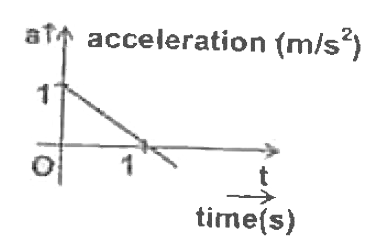A particle is forced to meove on a straight line path. It returns to the starting point after 10seconds.The→taldistancecoveredbythepartic≤dur∈gthistimeis 20 m. Which of the foolowing statements are true regarting the motion of the particles .
the average velocity of the particle is zero
the displacement of the particle is zero
the average speed of the particle is 2.0ms−1
the displacement of the particle is 20m.
The correct Answer is:A, B, C
When a particle whil movign returns to its initial position after a crtain time . Then its displacemnt in tha time is zero . Its average velocity (= diosplacement / time 0 is also zero. But its average speed = (total distance travelled)/(time taken ) = ( 20) /(10) <br> 2.0 ms^(-1)
Topper's Solved these Questions
- BOOK - PRADEEPCHAPTER - KINEMATICSEXERCISE - 4 NCERT multiple Choice10videos
KINEMATICS
- BOOK - PRADEEPCHAPTER - KINEMATICSEXERCISE - 4 NCERT Integer type4videos
KINEMATICS
- BOOK - PRADEEPCHAPTER - KINEMATICSEXERCISE - 2 NCERT multiple15videos
KINEMATICS
- BOOK - PRADEEPCHAPTER - GRAVIATIONEXERCISE - Assertion-Reason Type Questions19videos
GRAVIATION
- BOOK - PRADEEPCHAPTER - LAWS OF MOTIONEXERCISE - Assertion- Reason Type Questions17videos
LAWS OF MOTION
Similar Questions
A particle starting from rest moves in a straight line with acceleration as shown in the a-t graph. Find the distance (in m) travelled by the particle in the first four seconds from start of its motion.
Q View Solution
View SolutionA particle is moving along a straight line with uniform retardation of 2ms−2 The initial speed of particle is 20m/s .The distance travelled by the particle during the last one second before it stops is
View Solution
Knowledge Check
- Question 1 - Select One
A particle is constrained to move on a straight line path. It returns to the starting point after 10 sec . The total distance covered by the particle during this time is 30 m . Which of the following statements about the motion of the particle is false
ADisplacement of the particle is zeroBAverage speed of the particle is 3m/sCDisplacement of the particle is 30mDBoth (a) and (b) - Question 2 - Select One
Which of the following statements is not correct regarding the motion of a particle in a straight line?
Ax-t graph is a parabola, if motion is uniformly accelerated.Bv-t is a straight line inclined to the time-axis, if motion is uniformly accelerated.Cx-t graph is a straight line inclined to the time axis if motion is uniform and acceleration is zero.Dv-t graph is a parabola if motion is uniform and acceleration is zero. - Question 3 - Select One or More
A particle starts moving along a straight line path with velocity 10m/s. After 5s the distance of the particle from the starting point is 50m. Which of the following statements about the nature of motion of the particle are correct?
AThe body may be speeding up with a constant positve acceleration.BThe body may be moving with a constant velocity.CThe body may have a constant negative acceleration.DThe body may be first accelerated and then retarded.
A particle starts from the origin and moves along a stright line If the velocity of the particle at time t seconds 10t cm/s then find the distance traversed during fist seconds after the start.
View SolutionIn the Q.122 how much distance is covered by the particle in returning to the starting point?
View SolutionThe displacement time graph of a particle executing S.H.M. (in straight line) is shown. Which of the following statements is true?
 View Solution
View SolutionStarting from rest, a particle confined to move along a straight line is accelerated at a rate of 5.0 m/s2. Which one of the following statements accurately describes the motion of this particle ?
View SolutionA particle, initially at rest, starts moving in a straight line with an acceleration a=6t+4m/s2. The distance covered by it in 3 s is
View Solution

